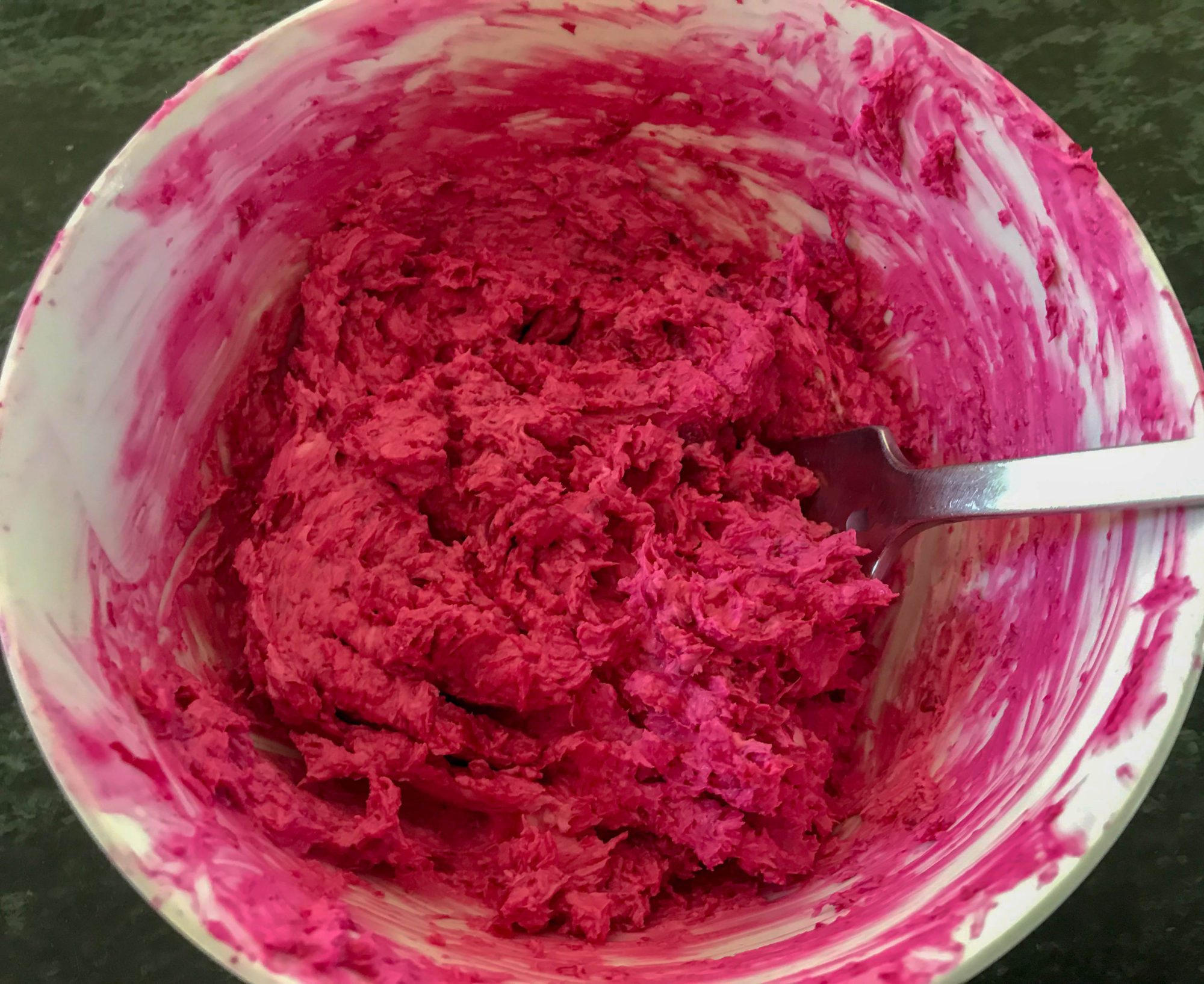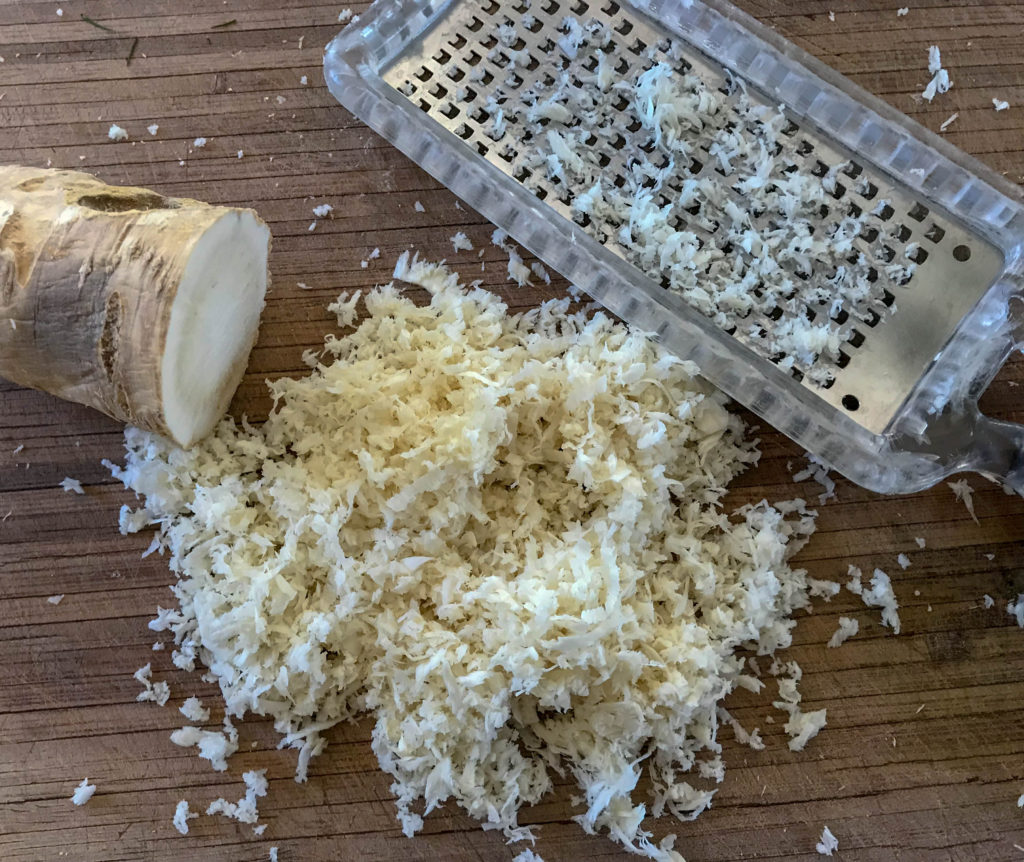A wildly colorful, nose-clearing schmear that can sneak equally well into roast beef sandwiches and salmon sushi.

Before you dump everything in a food processor and hit Go (the nuclear option), consider using the bowl and fork method, as pictured above. The reason being: fresh horseradish varies widely in heat, and the cut ends lose their potency first. Also, fresh raw beets are reliably sweet, but if you have purchased them pre-cooked in a little plastic bag, expect nothing more than neutrality. So, here's what I recommend:
Cook your own beets. Preheat the oven to 425, trim the roots and tops, wash and then oil the outsides, and place them in a small baking dish lined with aluminum foil. Roast until easily penetrated with a fork, about 45 minutes to an hour. Remove and, once cool, rub the skins off with your hands under a trickle of cold running water, with maybe a little assistance from a paring knife. Pick a nice, medium-sized specimen and microplane it into a bowl. It will be more granulated than shredded, quite juicy, and stain everything it touches.
Slice off about a half-inch chunk of the fresh horseradish to start with, pare off the peel, and microplane when you are ready to mix.
Somewhere along in here, take your cream cheese out of the fridge and let it rest at room temperature for a half-hour or so, to soften up. When all is ready, place the cream cheese in a small bowl and stir in some of the horseradish, tasting frequently until you get to the heat you desire. For the plain horseradish version, add the salt, vinegar and dill, stir up and adjust again, according to your taste. If you are forced to use jarred horseradish, omit the extra vinegar.
For the beet version - which is amazingly colorful, and is meant to be a little sweet/hot - stir in the grated beet and salt, then taste. If you used canned or prepackaged cooked beets, you might want to add a bit of sugar.
The only remaining question is - what do you do with this amazing stuff? Exactly how is it suited to a bagel? My original vision involved an egg bagel, either schmear, a pile of thinly-sliced roast beef and some pickled red onion. If you'll be patient, I'll make one soon and take a picture. But in the heat of the moment, almost all of this recipe went into a sushi platter. I mated up the beet schmear, soy-cured salmon, avocado, and cucumber into some nori and California rolls. They were great, but it was an ugly win - the schmear, in this case, lived up to its name. I'm going to try again with a pastry bag, and a little more practice. Some things that you love are still best not revealed in public, or at least not until they're properly dressed.

Ingredients
Directions
Before you dump everything in a food processor and hit Go (the nuclear option), consider using the bowl and fork method, as pictured above. The reason being: fresh horseradish varies widely in heat, and the cut ends lose their potency first. Also, fresh raw beets are reliably sweet, but if you have purchased them pre-cooked in a little plastic bag, expect nothing more than neutrality. So, here's what I recommend:
Cook your own beets. Preheat the oven to 425, trim the roots and tops, wash and then oil the outsides, and place them in a small baking dish lined with aluminum foil. Roast until easily penetrated with a fork, about 45 minutes to an hour. Remove and, once cool, rub the skins off with your hands under a trickle of cold running water, with maybe a little assistance from a paring knife. Pick a nice, medium-sized specimen and microplane it into a bowl. It will be more granulated than shredded, quite juicy, and stain everything it touches.
Slice off about a half-inch chunk of the fresh horseradish to start with, pare off the peel, and microplane when you are ready to mix.
Somewhere along in here, take your cream cheese out of the fridge and let it rest at room temperature for a half-hour or so, to soften up. When all is ready, place the cream cheese in a small bowl and stir in some of the horseradish, tasting frequently until you get to the heat you desire. For the plain horseradish version, add the salt, vinegar and dill, stir up and adjust again, according to your taste. If you are forced to use jarred horseradish, omit the extra vinegar.
For the beet version - which is amazingly colorful, and is meant to be a little sweet/hot - stir in the grated beet and salt, then taste. If you used canned or prepackaged cooked beets, you might want to add a bit of sugar.
The only remaining question is - what do you do with this amazing stuff? Exactly how is it suited to a bagel? My original vision involved an egg bagel, either schmear, a pile of thinly-sliced roast beef and some pickled red onion. If you'll be patient, I'll make one soon and take a picture. But in the heat of the moment, almost all of this recipe went into a sushi platter. I mated up the beet schmear, soy-cured salmon, avocado, and cucumber into some nori and California rolls. They were great, but it was an ugly win - the schmear, in this case, lived up to its name. I'm going to try again with a pastry bag, and a little more practice. Some things that you love are still best not revealed in public, or at least not until they're properly dressed.


Leave a Reply